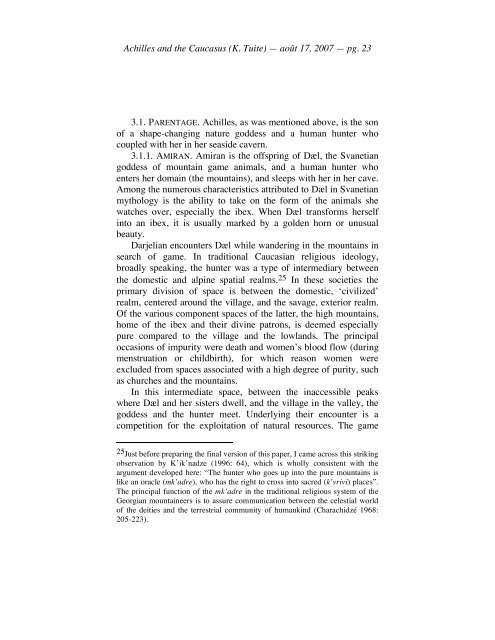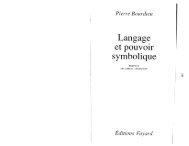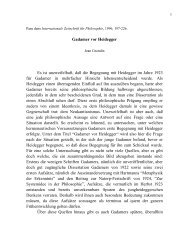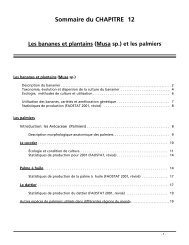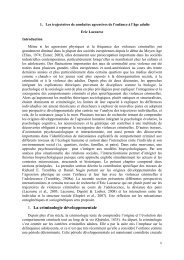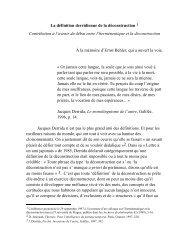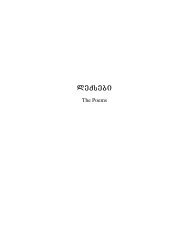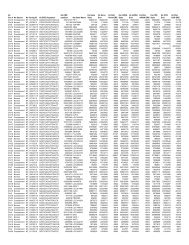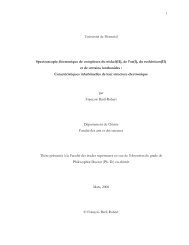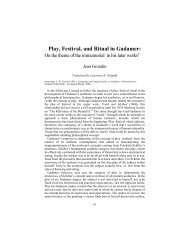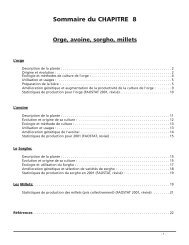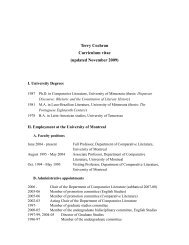Achilles and the Caucasus - Université de Montréal
Achilles and the Caucasus - Université de Montréal
Achilles and the Caucasus - Université de Montréal
Create successful ePaper yourself
Turn your PDF publications into a flip-book with our unique Google optimized e-Paper software.
<strong>Achilles</strong> <strong>and</strong> <strong>the</strong> <strong>Caucasus</strong> (K. Tuite) — août 17, 2007 — pg. 23<br />
3.1. PARENTAGE. <strong>Achilles</strong>, as was mentioned above, is <strong>the</strong> son<br />
of a shape-changing nature god<strong>de</strong>ss <strong>and</strong> a human hunter who<br />
coupled with her in her seasi<strong>de</strong> cavern.<br />
3.1.1. AMIRAN. Amiran is <strong>the</strong> offspring of Dæl, <strong>the</strong> Svanetian<br />
god<strong>de</strong>ss of mountain game animals, <strong>and</strong> a human hunter who<br />
enters her domain (<strong>the</strong> mountains), <strong>and</strong> sleeps with her in her cave.<br />
Among <strong>the</strong> numerous characteristics attributed to Dæl in Svanetian<br />
mythology is <strong>the</strong> ability to take on <strong>the</strong> form of <strong>the</strong> animals she<br />
watches over, especially <strong>the</strong> ibex. When Dæl transforms herself<br />
into an ibex, it is usually marked by a gol<strong>de</strong>n horn or unusual<br />
beauty.<br />
Darjelian encounters Dæl while w<strong>and</strong>ering in <strong>the</strong> mountains in<br />
search of game. In traditional Caucasian religious i<strong>de</strong>ology,<br />
broadly speaking, <strong>the</strong> hunter was a type of intermediary between<br />
<strong>the</strong> domestic <strong>and</strong> alpine spatial realms. 25 In <strong>the</strong>se societies <strong>the</strong><br />
primary division of space is between <strong>the</strong> domestic, ‘civilized’<br />
realm, centered around <strong>the</strong> village, <strong>and</strong> <strong>the</strong> savage, exterior realm.<br />
Of <strong>the</strong> various component spaces of <strong>the</strong> latter, <strong>the</strong> high mountains,<br />
home of <strong>the</strong> ibex <strong>and</strong> <strong>the</strong>ir divine patrons, is <strong>de</strong>emed especially<br />
pure compared to <strong>the</strong> village <strong>and</strong> <strong>the</strong> lowl<strong>and</strong>s. The principal<br />
occasions of impurity were <strong>de</strong>ath <strong>and</strong> women’s blood flow (during<br />
menstruation or childbirth), for which reason women were<br />
exclu<strong>de</strong>d from spaces associated with a high <strong>de</strong>gree of purity, such<br />
as churches <strong>and</strong> <strong>the</strong> mountains.<br />
In this intermediate space, between <strong>the</strong> inaccessible peaks<br />
where Dæl <strong>and</strong> her sisters dwell, <strong>and</strong> <strong>the</strong> village in <strong>the</strong> valley, <strong>the</strong><br />
god<strong>de</strong>ss <strong>and</strong> <strong>the</strong> hunter meet. Un<strong>de</strong>rlying <strong>the</strong>ir encounter is a<br />
competition for <strong>the</strong> exploitation of natural resources. The game<br />
25 Just before preparing <strong>the</strong> final version of this paper, I came across this striking<br />
observation by K’ik’nadze (1996: 64), which is wholly consistent with <strong>the</strong><br />
argument <strong>de</strong>veloped here: “The hunter who goes up into <strong>the</strong> pure mountains is<br />
like an oracle (mk’adre), who has <strong>the</strong> right to cross into sacred (k’vrivi) places”.<br />
The principal function of <strong>the</strong> mk’adre in <strong>the</strong> traditional religious system of <strong>the</strong><br />
Georgian mountaineers is to assure communication between <strong>the</strong> celestial world<br />
of <strong>the</strong> <strong>de</strong>ities <strong>and</strong> <strong>the</strong> terrestrial community of humankind (Charachidzé 1968:<br />
205-223).


